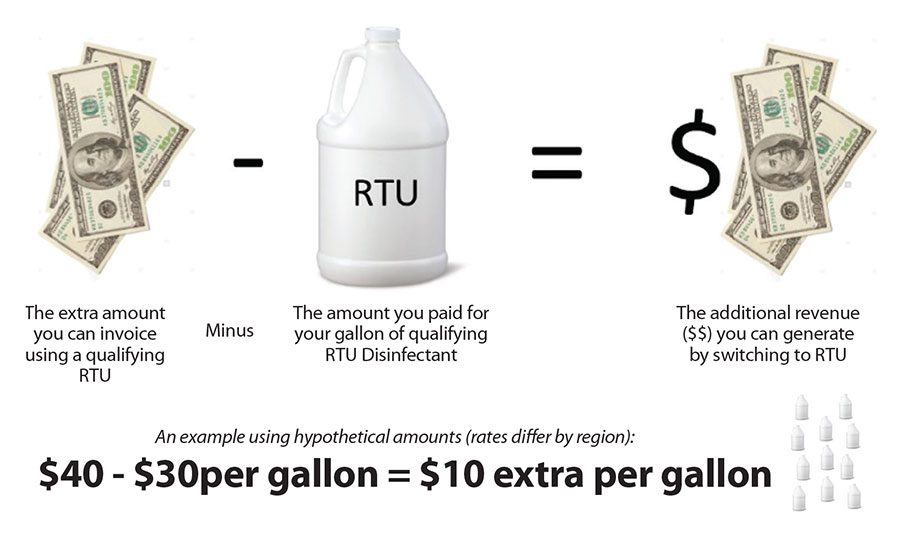It’s safe to say math was one of my least favorite subjects in school. Well, as I have discovered over the years and I’m sure you have too… math is required in just about everything we do and there’s no escape. Fortunately, with just a little effort and minimal math skills, we can use math to save money… and make more money!
At first glance, one might be tempted to use the simplest math possible when choosing a disinfectant. If you use a concentrated disinfectant that requires mixing with water to create the ready-to-use dilution, it looks like you can save a lot of money. Here’s the calculation:
If you compare that to most RTU disinfectants (the kind you spray right out of the bottle without mixing), you’ll see that they range from $25 up to around $40! So, you think to yourself, “Wow, I’m paying less than a dollar per gallon instead of 30 bucks or so!”
Well, that’s all fine and good, but there’s another side to using disinfectants and that’s getting paid for applying them. If you are using Xactimate or just about any other line-item based billing/invoicing/estimating system, you are going to charge money for applying disinfectant.
Currently the most common way to charge for applying a disinfectant is to use a line-item code for each square foot of surface applied. Considering that most disinfectants have coverage rates somewhere between 800 and 1,200 sq ft, you are able to bill out a significant amount for that one gallon (remembering of course that the line item amount also includes the labor to apply it and other factors). Check out the math above.
Here’s where it gets weird though. Remember that “expensive” RTU disinfectant that costs around $30 per gallon to apply? Well, if that disinfectant qualifies for the Xactimate GRMB code (or similar code in other pricing/estimating systems) you can charge a few more cents per square foot for using it. There is some debate among a few people in the industry as to which products qualify for this special code, but I’ve always contended that there are several. What there is no debate on is that concentrated disinfectants don’t qualify. Here’s the current Xactimate description so you can decide for yourself if your RTU disinfectant qualifies:
Xactimate GRMB Definition:
Includes: Anti-microbial agent and labor.
Note: The surface is treated to kill harmful bacteria and/or prevent mildew. This item is for applying a plant-based or equal environmentally-safe alternative to chemical-based anti-microbials.
How much more per square foot can you charge for applying an RTU Disinfectant that qualifies for the GRMB code? That depends heavily on the codes in your region, but let’s do a hypothetical example of the math:
In other words, by switching to an RTU disinfectant that qualifies for the special “Bio” code, you can invoice more additional dollars per gallon than what that RTU gallon costs! Weird right?
Remember, you will have to do the math for yourself since a lot depends on the pricing codes in your region and your estimating/pricing system… as well as what you are paying for a quality RTU disinfectant. The point is, you aren’t saving much by mixing concentrates and it’s likely you are actually invoicing less than what you could be if you were using an RTU.
Where it becomes a no-brainer though is when you consider the other differences between the standard quaternary ammonia-based disinfectant concentrates and the RTU products that qualify for the GRMB code.
One of the most important factors to consider when choosing an antimicrobial (disinfectant) is liability. Liability issues in disinfectants come in two primary forms. First, the product needs to be strong in killing a broad spectrum of microbes. The best way to document this is to choose a disinfectant registered by the EPA as a “Tuberculocide.” If the word, “Tuberculocidal” is not on the front label, that product is not as strong as a product that does have that on the label.
Second, be sure to compare each section of the SDS sheet. Products that qualify for the GRMB code are going to be safe and have no words like “Danger,” “Warning,” or “Caution,” anywhere on the label or SDS sheet. Nowadays everything we can do to reduce liability is important.
I said it would be a no-brainer so let’s review. Switching from a concentrated disinfectant to a GRMB-qualifying RTU Tuberculocide disinfectant is going to: 1. Generally make you more money and 2. Reduce your liability exposure.
…but don’t take my word for it, do the math!





